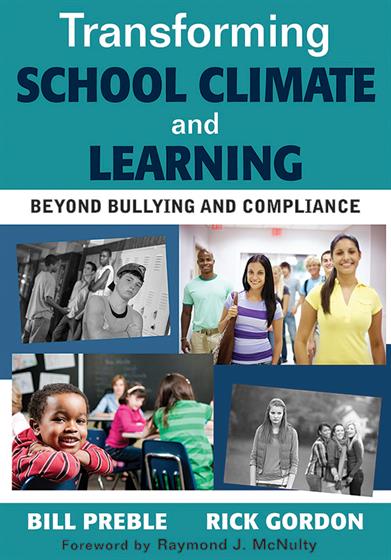Foreword by Raymond J. McNulty
Acknowledgments
About the Authors
Introduction: Bringing Our Schools Into Balance
Beyond Bullying, Beyond Compliance
Getting Beyond Piecemeal Problem Solving
The Rational for This Book: School Climate as a Key to School Safety, Student Motivation, and Academic Achievement
Guideposts for School Leaders: Administrators, Teachers, AND Students
Organization of the Book
Why Read This Book?
Students and Teachers as Partners in Transforming School Climate
1. School Climate: The Heart and Soul of a School
Making Meaningful Improvement in Schools
Why Is School Climate Important?
School Climate and Effective Schools
Essential School Climate Factors
We All Want Respectful Schools
What Teachers and Students Mean by Respect
Beeper Studies: Our Original Research on Respectful Schools
The Respect Continuum: A Practical Theory of Respect
The Disrespect Side of the Continuum
The Respect Side of the Continuum
How Schools Use the Respect Continuum
Initial Success in One District
Looking Beyond Stopping Misbehavior
Making It Real: A Real-Life Respectful School
Conclusion
Book Study Questions
2. The SafeMeasures Process: A Student-Led, Collaborative Action Research Process
Sarason's Research on School Change
Balancing Adult and Student Leadership
The SafeMeasures Process: An Overview
Bandura's Research on Self-Efficacy
Looking Deeply at Collaborative Action Research
Emancipatory Research
Making It Real: School Climate Improvement
Conclusion
Book Study Questions
3. Stage One: Everyone Is a Leader: Empowering Students and Teachers
The Dignity of Expertise
Getting Started
Administrative Support Is Essential
The Adult Design Team: Membership and Roles
National School Climate Standards as a Guide to Action
Selecting a Diverse Team of Student Leaders
Challenges to Choosing a Diverse Team of Student Leaders
Making it Real: Student Leadership Training
Conclusion
Simple Summary: Stage One
Book Study Questions
4. Stage Two: Including All Voices: School Climate Data Collection
The Importance of Data
What Gets Measured Is What Gets Done
Some Potential Problems With School Data Collection
What and How to Measure
What to Do With Data
When Students Become School Climate Researchers
The Power of Qualitative Data
The Value of Quantitative Data
Making It Real: Elementary School Student Researchers
Conclusion
Simple Summary: Stage Two
Book Study Questions
5. Stage Three: Thinking Together: Data Analysis and Goal Setting
Internal or External Locus of Control: Whose Responsibility
Cognitive Dissonance: Wrestling With Data to Construct Meaning
No Fault, No Blame
Words or Numbers? Analyzing Data With Students
Using Quantitative Data Effectively
Goal Setting With Student Leaders
Why Students Lead the Way: Student and Teacher Data Analysis and Goal Setting
Faculty Data Analysis and Goal Setting
The Work of Goal-Based Action Teams
Making It Real: Data Analysis and Goal Setting With Chain Reaction
Conclusion
Simple Summary: Stage Three
Book Study Questions
6. Stage Four: Making Change Happen: Action Planning and Project Development
Action Planning: Where Change Begins
No One Best System
School Climate Action Teams: Working Effectively With Colleagues
Action Planning Steps
Using the Respect Continuum as a Guide to Action
Moving Toward the Positive
Respectful Teaching
Balanced Leadership: Adults and Students Joining Forces for Change
Making It Real: The Backpack Project
Conclusion
Simple Summary: Stage Four
Book Study Questions
7. Stage Four Specifics: Action Projects to Promote Respectful Teaching and Learning
Changing School Climate Through Respectful Teaching
Engagement Strategies That Work
Providing Students With Choices
Authentic, Applied, Real-World Learning
Altering the Schedule to Provide Learning Opportunities
Making It Real: Sugata Mitra's Hole-in-the-Wall Project
Conclusion
Simple Summary: Stage Four Specifics
Book Study Questions
8. Stage Five: Moving Forward Together: Sustainability and Continuous Improvement
Change Is a Process, Not an Event
Key Elements of Sustainable Change
Closing the Gaps
Dignity and Respect
The Best People Working on the Problem
Socially Based and Action-Oriented Change
Enhance, Extend, and Empower
Make a Multiyear Commitment
Formative Assessment: A Critical Part of the Process
Aligning School Climate and Learning: Demonstrate a Balanced Approach
Guideposts for Sustainability
Making It Real: Talking Walls
Conclusion
Simple Summary: Stage Five
Book Study Questions
9. The Road Ahead: Transforming School Climate and Learning
When Will the Time Be Right?
Continued Resistance, Growing Hope
School Climate As a Coherent Framework for Understanding Schools
Implications for School Leaders, Teachers, and Students
Conclusion
Book Study Questions
List of Appendices
Appendix A: From Violence to Empowerment: A Respect Continuum
Appendix B: Sample School Climate Data Summary
Appendix C: Example of Student Goals and Evidence of Need: Elementary School Data (Grades 3–6)
References
Index




